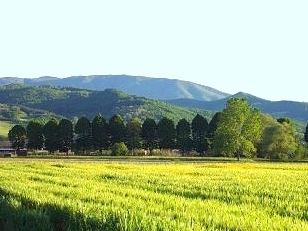
Last week I decided to spend a Sunday in
Mugello, a wonderful corner of tuscan countryside, rich in nature, art and history, just a few kilometres away from Florence.
Mugello was dominated by Etruscan first, then by Romans. In the middle ages was territory of the
Guidi and
Ubaldini families, whose fought Florence. Then from 1300 the Mugello became an important area for Florence, because of its strategic and economic importance.
Several important buildings and fortresses, castles, villas, monasteries and palaces still bear witness to this important period of growth in Mugello. In fact, even the artistic and cultural history of Florence owes much of its development to Mugello: artists such as
Giotto and
Beato Angelico were born here; important architects worked on the construction of the castles and moreover, the
Mugello landscape has provided inspiration for numerous Florentine paintings.
I decided to follow the
“Medici Route”, discovering the places where the Medici family lived nad ruled.
The tour starts in
Scarperia, which was founded by the town of Florence at the beginning of the 14th century, and still conserves the impressive
Palazzo dei Vicari, which was built in the same period but has undergone numerous transformations and restorations throughout the centuries. Palazzo Vicari houses the
Museo dei Ferri Taglienti - antique and modern cutlery – as Scarperia is well known for knife handcrafts.
From Scarperia move to the small town of
Sant’Agata, where there is a beautiful Romanesque church, the most famous sacred structure in Mugello.
Then visit the
Bosco ai Frati Convent, which was built according to
Michelozzo’s design, by order of
Cosimo dé Medici. Inside, you find the splendid
Crucifix by Donatello ( opened only on Saturday and Sunday morning because friars still live here).
Heading towards San Piero a Sieve, you find
Villa Medicea of Cafaggiolo, one of the favourite residences of
Lorenzo the Magnificent, and a splendid example of Renaissance architecture (visits must be booked). Not far away, towering above you, surrounded by century old cypress trees, you can admire the
Trebbio Castle: another magnificent Medici construction (private, visits only in special days).
In the next post I’ll let you know all those wonderful places!

 Palazzo Vecchio had always been the place where the governors ruled the city, the heart of the public life of Florence. Still today it houses the major of Firenze and several city offices.
Palazzo Vecchio had always been the place where the governors ruled the city, the heart of the public life of Florence. Still today it houses the major of Firenze and several city offices.







 Founded in the 11th century by the Ubaldini prior (of the feudatory family of Mugello), this convent is one of the most ancient in the whole Tuscany.
Founded in the 11th century by the Ubaldini prior (of the feudatory family of Mugello), this convent is one of the most ancient in the whole Tuscany. inside the church
inside the church  the altar of the church
the altar of the church
 the small cloyster of Bosco ai Frati
the small cloyster of Bosco ai Frati
 the mini-van of the Franciscan friars of Bosco ai Frati :-)
the mini-van of the Franciscan friars of Bosco ai Frati :-)





 frescos inside Palazzo dei Vicari
frescos inside Palazzo dei Vicari

 The church of Sant’Agata is in the heart of a small old town, Sant’Agata, near
The church of Sant’Agata is in the heart of a small old town, Sant’Agata, near 
 the small cloyster of the church
the small cloyster of the church the baptismal font of XII century, church of Sant'Agata, Mugello
the baptismal font of XII century, church of Sant'Agata, Mugello the entrance of the church of Sant'Agata
the entrance of the church of Sant'Agata
 Scarperia is a small village in the heart of Mugello, known for the handcraft of knives, and is one of the most beautiful villages of Italy (see the site of
Scarperia is a small village in the heart of Mugello, known for the handcraft of knives, and is one of the most beautiful villages of Italy (see the site of 














 Last week I decided to spend a Sunday in Mugello, a wonderful corner of tuscan countryside, rich in nature, art and history, just a few kilometres away from Florence.
Last week I decided to spend a Sunday in Mugello, a wonderful corner of tuscan countryside, rich in nature, art and history, just a few kilometres away from Florence.

 Piazza della Signoria is an square in front of the Palazzo Vecchio in Florence. Infact it was named after the Palazzo della Signoria, also called Palazzo Vecchio.
Piazza della Signoria is an square in front of the Palazzo Vecchio in Florence. Infact it was named after the Palazzo della Signoria, also called Palazzo Vecchio.



